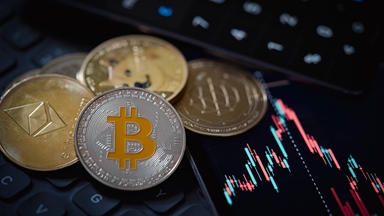Loading component...
At a glance
By Gary Anders
The Hydra of Lerna was a fearsome creature in Greek mythology that had multiple heads.
When one of its heads was cut off, two more would immediately grow back in its place, making the Hydra almost impossible to defeat. It took the divine hero Hercules, the son of Zeus, to do that.
Right now, governments and regulators around the world are grappling with something could be described as a modern‑day Hydra in terms of sheer complexity – crypto assets.
Crypto assets are evolving at lightning speed. This presents significant challenges in determining how different types of crypto assets should be accounted for and taxed.
Crypto assets, which are also referred to as virtual assets and digital assets, go well beyond cryptocurrencies – of which there are currently almost 24,000. They include any asset that can be stored digitally, recorded on a blockchain, is uniquely identifiable and can be used to realise value.
Rapid technological advances are making it tougher for governments and regulators to keep up with changes in the global crypto ecosystem. Token mapping is one measure that may help make a difference along the way.
Token mapping, explained
In February 2023, as part of the Australian Government’s broader Digital Economy Strategy, Treasury released a detailed consultation paper on “token mapping”.
The paper is a foundational step in developing appropriate regulatory settings for Australia’s crypto ecosystem.
Token mapping involves identifying the key activities and functions of crypto products and mapping them against Australia’s existing regulatory frameworks, especially the financial services framework.
The Australian Government has already consulted on licensing and custody requirements for crypto asset secondary service providers (CASSPrs), under a proposed Digital Services Act that will address regulatory gaps.
CASSPrs either offer crypto asset custody, storage, brokering, exchange and dealing services, or they operate a market in crypto assets for retail consumers, such as peer-to-peer exchanges.
Approaches across the globe

A key challenge for Australia on the regulatory front is around how to integrate crypto assets into existing legislation.
What is happening in overseas jurisdictions offers some clues, but it is evident many are going their own way at this stage.
“Globally, the regulatory frameworks for the crypto ecosystem are being actively considered with different approaches emerging,” Treasury’s token mapping consultation paper notes.
According to the paper, some jurisdictions, such as Japan and Singapore, have started to modernise existing legislation. The European Union has opted to draft crypto-specific legislation.
Policy responses have ranged from bans, such as in Mainland China and Iraq, to government entities issuing crypto token bonds, as in Hong Kong. Some nations, such as the UK and Singapore, have announced their goal to become “crypto hubs”, while Indonesia has announced its plan to establish a national crypto asset exchange.
Hong Kong is at the forefront of the crypto assets revolution, having announced in October 2022 its intent to become a global virtual assets leader. In early 2023, the Securities and Futures Commission, Hong Kong’s securities regulator, introduced new rules to enable retail investors to buy digital tokens on licensed platforms.
“We will let the industry develop and innovate,” says Eddie Yue Wai-man, chief executive of the Hong Kong Monetary Authority.
“We will let them create the ecosystem here, and that actually brings a lot of excitement, but that doesn’t mean ‘light touch’ regulation.
"We have identified that there is some diversity in how these assets are accounted for. We’ve been aware of this being an issue for some time, and it’s really come front of mind once again as part of this intangibles project."
“Let’s put in the right regulatory framework in using the principle of same activity, same risk and same regulation.”
The Bank for International Settlements this year released a paper that outlines regulatory options in its BIS Bulletin.
The paper notes that the recent collapses of several crypto firms have “re-ignited the debate on the appropriate policy response to address the risks in crypto, including through regulation”.
“Authorities may consider different – not mutually exclusive – lines of action to tackle the risks in crypto. These include containment or regulation of the crypto sector or an outright ban.”
Australia’s Treasury says its token mapping approach will help ensure consistency through technology-neutral regulation activities. The approach will make use of existing policy goals, rather than requiring “the wholesale creation and adoption of a standalone policy”.
The Australian Government’s timetable for finalising crypto legislation is not yet clear.
The crypto question for Australia's financial regulators
Accounting for crypto assets
The Australian Accounting Standards Board (AASB) has been reviewing accounting for crypto assets since 2016.
The AASB has now expanded its focus, as part of a much bigger project that looks at accounting for intangible assets.
On the tax front, the Australian Taxation Office (ATO) provides detailed guidance on the tax treatment of crypto assets under current legislation, which includes discussion of capital gains tax.
“We’ve started a research project looking into what, if anything, should be done about accounting for crypto assets,” says Dr Keith Kendall FCPA, the AASB’s chair.
“We have identified that there is some diversity in how these assets are accounted for. We’ve been aware of this being an issue for some time, and it’s really come front of mind once again as part of this intangibles project,” Kendall adds.
Kendall says the AASB is yet to decide whether the current Australian Accounting Standards need to be changed or if they can accommodate crypto assets.
The International Accounting Standards Board (IASB) is currently examining the same question and has incorporated crypto assets into its larger intangible assets project.
“The state of the market in Australia is very much at the early stages, so the crypto transactions of most of the entities we have surveyed are not material,” Kendall says.
“To my mind, this suggests we’re starting this research at the right time. We’ve been engaging in this, looking at what’s going on in practice and trying to get a handle on things before material transactions start taking place.”
The AASB’s intangible assets project has a broad timeline of two years.
Current accounting standards allow crypto assets to be accounted for as either intangible assets when held, or as inventory (stock) when traded.
For accounting purposes, crypto assets are not considered financial instruments, such as an equivalent to cash.
Separate approach needed for crypto assets
Ram Subramanian CPA, CPA Australia’s senior manager – reporting policy, says the IASB should be conducting a separate project on accounting for crypto assets rather than considering it as part of their intangible assets project.
“It’s not an ideal outcome, but there’s some validity behind it, as the economic activities represented by crypto assets are not significant presently within the listed entities space.”
Outside this segment of the economy, according to the Australian Treasury, more than one million Australians are expected to include crypto assets on their tax returns for the 2022-2023 financial year.
According to US blockchain analysis firm Chainalysis, Australia ranks 40th globally for crypto adoption. Retail transactions at centralised exchanges also rank 40th globally when measured by purchasing power parity per capita.
"There are a lot of situations where these concepts haven’t been explored yet, in terms of how they should be taxed. A lot of the time accountants are trying to use existing frameworks to apply to crypto, and one tax situation that looks similar might not actually be the same problem."
The Financial Accounting Standards Board (FASB) in the US has started a separate project looking at accounting for crypto assets.
“They are slightly ahead of the game compared to the IASB,” Subramanian says.
“Clearly, they see a need for an accounting solution for organisations that transact in or hold crypto assets.”
Notably, the FASB is only looking at the buyers and sellers of crypto assets, rather than the facilitating trading platforms or the issuers of crypto assets.
The European Financial Reporting Advisory Group has conducted a research project on crypto assets, and has suggested the IASB pick up crypto assets as a separate accounting project.
Subramanian says that accounting standards are sometimes developed to address an identified accounting problem.
“The classic example is when we had the global financial crisis back in 2010-2011. One of the issues that was considered a problem at that time was the accounting for financial instruments.
“In response, the IASB came up with a new accounting standard for financial instruments called IFRS 9. A more proactive approach would be welcome here.”
Cryptocurrency crash: how crypto volatility impacts the economy
Crypto: a tax labyrinth
Adrian Forza CPA, director of cryptocurrency tax advice firm Crypto Tax Australia, says the crypto ecosystem “doesn’t fit” in the traditional accounting sense.
“You’ve always got your debits and credits, but what you can do with these technologies is very new and hasn’t really been done before,” Forza says.
“In terms of token mapping, the biggest issue is classification and the nuances. There are a lot of situations where these concepts haven’t been explored yet in terms of how they should be taxed.
“A lot of the time accountants are trying to use existing frameworks to apply to crypto, and one tax situation that looks similar might not actually be the same problem.
“Every day there are new ways to interact with cryptocurrency... and that’s just something that accountants will need to deal with,” he explains.
Configuring tax legislation
Elinor Kasapidis, CPA Australia’s head of policy and advocacy, says, “From a tax perspective, we just want to make sure [crypto assets] are treated the same.
“The legislation needs to be designed to fit into the current ways that financial assets are taxed. Where it might differ, we need to have specific legislation to make sure the outcomes are the same.”
Crypto assets can become complicated because the technology and the contracts around them are quite different to what might normally occur, Kasapidis adds.
“There’s a whole data and accounting piece around that, to make sure that investors understand how it needs to be treated for accounting and tax purposes.
“That’s been quite challenging, just because of how these assets work. It’s not quite the same as a contract to sell property or a simple share trade through a stock exchange. There are a lot of novel and diverse ways you can invest in and dispose of financial assets. Many investors may not be familiar with the tax consequences each time they do something.”
Kasapidis points to how the US is effectively leading the crypto charge, with the Securities and Exchange Commission attempting to regulate crypto assets the same way as other financial instruments.
“Australia seems to be taking a ‘steady as she goes’ approach and is looking at what other jurisdictions such as the EU and the US are doing. We would support that, because, ultimately, we want to have consistency and alignment globally in how regulators and investors approach these assets,” Kasapidis explains.
“Other jurisdictions that might be smaller may have an openness to try new ideas. However, countries like Australia will be fitting in more like the US to try to accommodate them into the existing system as much as possible.
“You can see how this industry is growing and regulators are struggling to catch up,” Kasapidis says.
“The next few years will be important for the industry and governments, to make sure they have a handle, and that consumers and investors are protected.”

